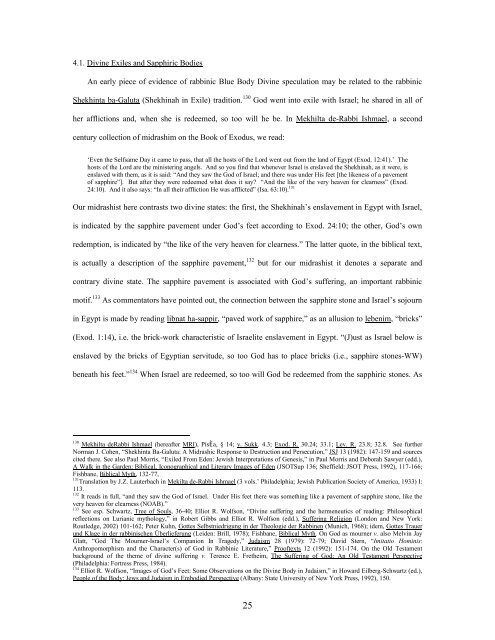Sapphiric God: - Dr. Wesley Muhammad
Sapphiric God: - Dr. Wesley Muhammad
Sapphiric God: - Dr. Wesley Muhammad
You also want an ePaper? Increase the reach of your titles
YUMPU automatically turns print PDFs into web optimized ePapers that Google loves.
4.1. Divine Exiles and <strong>Sapphiric</strong> Bodies<br />
An early piece of evidence of rabbinic Blue Body Divine speculation may be related to the rabbinic<br />
Shekhinta ba-Galuta (Shekhinah in Exile) tradition. 130 <strong>God</strong> went into exile with Israel; he shared in all of<br />
her afflictions and, when she is redeemed, so too will he be. In Mekhilta de-Rabbi Ishmael, a second<br />
century collection of midrashim on the Book of Exodus, we read:<br />
‘Even the Selfsame Day it came to pass, that all the hosts of the Lord went out from the land of Egypt (Exod. 12:41).’ The<br />
hosts of the Lord are the ministering angels. And so you find that whenever Israel is enslaved the Shekhinah, as it were, is<br />
enslaved with them, as it is said: “And they saw the <strong>God</strong> of Israel; and there was under His feet [the likeness of a pavement<br />
of sapphire”]. But after they were redeemed what does it say? “And the like of the very heaven for clearness” (Exod.<br />
24:10). And it also says: “In all their affliction He was afflicted” (Isa. 63:10). 131<br />
Our midrashist here contrasts two divine states: the first, the Shekhinah’s enslavement in Egypt with Israel,<br />
is indicated by the sapphire pavement under <strong>God</strong>’s feet according to Exod. 24:10; the other, <strong>God</strong>’s own<br />
redemption, is indicated by “the like of the very heaven for clearness.” The latter quote, in the biblical text,<br />
is actually a description of the sapphire pavement, 132 but for our midrashist it denotes a separate and<br />
contrary divine state. The sapphire pavement is associated with <strong>God</strong>’s suffering, an important rabbinic<br />
motif. 133 As commentators have pointed out, the connection between the sapphire stone and Israel’s sojourn<br />
in Egypt is made by reading libnat ha-sappir, “paved work of sapphire,” as an allusion to lebenim, “bricks”<br />
(Exod. 1:14), i.e. the brick-work characteristic of Israelite enslavement in Egypt. “(J)ust as Israel below is<br />
enslaved by the bricks of Egyptian servitude, so too <strong>God</strong> has to place bricks (i.e., sapphire stones-WW)<br />
beneath his feet.” 134 When Israel are redeemed, so too will <strong>God</strong> be redeemed from the sapphiric stones. As<br />
130 Mekhilta deRabbi Ishmael (hereafter MRI), PisÈa, § 14; y. Sukk. 4.3; Exod. R. 30.24; 33.1; Lev. R. 23.8; 32.8. See further<br />
Norman J. Cohen, “Shekhinta Ba-Galuta: A Midrashic Response to Destruction and Persecution,” JSJ 13 (1982): 147-159 and sources<br />
cited there. See also Paul Morris, “Exiled From Eden: Jewish Interpretations of Genesis,” in Paul Morris and Deborah Sawyer (edd.),<br />
A Walk in the Garden: Biblical, Iconographical and Literary Images of Eden (JSOTSup 136; Sheffield: JSOT Press, 1992), 117-166;<br />
Fishbane, Biblical Myth, 132-77,<br />
131 Translation by J.Z. Lauterbach in Mekilta de-Rabbi Ishmael (3 vols.’ Philadelphia; Jewish Publication Society of America, 1933) I:<br />
113.<br />
132 It reads in full, “and they saw the <strong>God</strong> of Israel. Under His feet there was something like a pavement of sapphire stone, like the<br />
very heaven for clearness (NOAB).”<br />
133 See esp. Schwartz, Tree of Souls, 36-40; Elliot R. Wolfson, “Divine suffering and the hermeneutics of reading: Philosophical<br />
reflections on Lurianic mythology,” in Robert Gibbs and Elliot R. Wolfson (edd.), Suffering Religion (London and New York:<br />
Routledge, 2002) 101-162; Peter Kuhn, Gottes Selbstniedrigung in der Theologie der Rabbinen (Munich, 1968); idem, Gottes Trauer<br />
und Klage in der rabbinischen Überlieferung (Leiden: Brill, 1978); Fishbane, Biblical Myth. On <strong>God</strong> as mourner v. also Melvin Jay<br />
Glatt, “<strong>God</strong> The Mourner-Israel’s Companion In Tragedy,” Judaism 28 (1979): 72-79; David Stern, “Imitatio Hominis:<br />
Anthropomorphism and the Character(s) of <strong>God</strong> in Rabbinic Literature,” Prooftexts 12 (1992): 151-174. On the Old Testament<br />
background of the theme of divine suffering v. Terence E. Fretheim, The Suffering of <strong>God</strong>: An Old Testament Perspective<br />
(Philadelphia: Fortress Press, 1984).<br />
134 Elliot R. Wolfson, “Images of <strong>God</strong>’s Feet: Some Observations on the Divine Body in Judaism,” in Howard Eilberg-Schwartz (ed.),<br />
People of the Body: Jews and Judaism in Embodied Perspective (Albany: State University of New York Press, 1992), 150.<br />
25
















